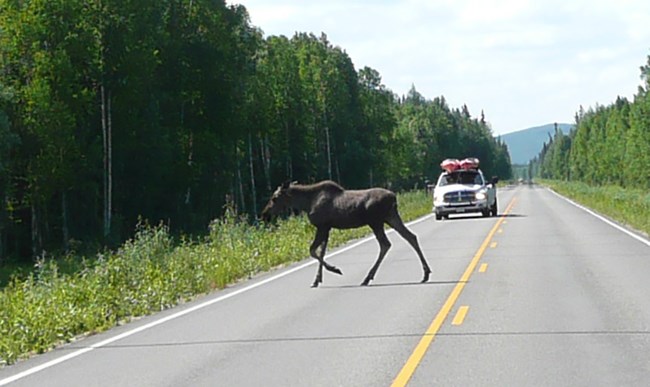Last updated: January 18, 2023
Article
Avoiding moose collisions

Wildlife-vehicle collisions (WVCs) are a major public safety and wildlife management issue. WVCs cause human deaths, damage property, and imperil wildlife. In the United States alone, two million collisions with ungulates (like deer and moose) kill approximately 440 people, injure about 59,000 people, and cause more than US$10 billion of economic losses annually. Collisions with moose are especially dangerous due to their large size and height. An international team of scientists, led by the University of Washington, investigated patterns of WVCs with moose in Alaska and Canada. Collisions were 2.4-5.7 times more frequent during winter (December-February) than early summer. Risk was greatest when and where snow depth was less than 47 inches. The analysis suggests that moose migrate into areas with less snow, which increased the risk of collision in those areas. Most (82%) moose-vehicle collisions occurred after dark. This pattern was strongest during winter, when nighttime traffic volumes were 8 times higher than summer due to longer nights (and the very short summer nights of high-latitude summer). This research may help predict times and places where the risk of moose-vehicle collisions is greatest and develop seasonally dynamic mitigation strategies.
Human and animal movements combine with snow to increase moose-vehicle collisions in winter
Abstract
Wildlife-vehicle collisions imperil humans, wildlife, and property. Collisions with moose (Alces alces) are especially consequential and there are indications they may increase during severe winters. We tested hypotheses regarding the influence of moose movements and vehicular traffic patterns on collision risk. We first modeled daily snow depth and accumulation across 5.6 million km2 of the North American Arctic-Boreal region. Next, we analyzed the movements and road use of 113 GPS-collared moose in response to snow depth. Finally, we examined the influence of these snow properties on vehicular traffic and 7,680 moose-vehicle collisions. As winter progressed and the snowpack deepened in each study area, GPS-collared moose migrated to lower elevations, leading them into areas with shallower snow but higher road densities. This elevational migration corresponded with a higher probability of road-use by moose (by up to ten-fold) in winter than in summer. Corresponding to these patterns, moose-vehicle collisions were 2.4-5.7 times more frequent from December through February (compared to early summer). Collision risk was highest when and where snow depth was less than 120 cm, indicating that migration into areas with shallower snow increased collision risk in those areas. Most (82%) moose-vehicle collisions occurred after dark. This pattern was strongest during winter, when nighttime traffic volumes were eight times higher than summer due to longer nights. Overall, our findings suggest that concurrent seasonal changes in human and wildlife behavior increase the frequency of moose-vehicle collisions during winter. Snow depth influences collisions primarily through its impacts on moose movement, while strong seasonal changes in daylight hours cause an increase in nighttime traffic that further contributes to risk. This information may help predict times and places where risk of moose-vehicle collisions are highest and to develop seasonally dynamic mitigation strategies.
Cunningham, C. X., G. E. Liston, A. K. Reinking, N. T. Boelman, T. J. Brinkman, K. Joly, M. Hebblewhite, S. Boutin, S. Czetwetynski, L. E. Sielecki, and L. R. Prugh. 2022. Human and animal movements combine with snow to increase moose-vehicle collisions in winter. Environmental Research 17: 125007.
